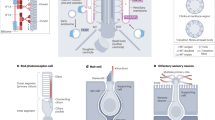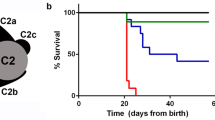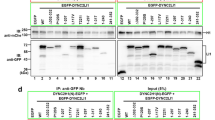Abstract
Cilia-associated human genetic disorders are striking in the diversity of their abnormalities and their complex inheritance. Inactivation of the retrograde ciliary motor by mutations in DYNC2H1 causes skeletal dysplasias that have strongly variable expressivity. Here we define previously unknown genetic relationships between Dync2h1 and other genes required for ciliary trafficking. Mutations in mouse Dync2h1 disrupt cilia structure, block Sonic hedgehog signaling and cause midgestation lethality. Heterozygosity for Ift172, a gene required for anterograde ciliary trafficking, suppresses cilia phenotypes, Sonic hedgehog signaling defects and early lethality of Dync2h1 homozygotes. Ift122, like Dync2h1, is required for retrograde ciliary trafficking, but reduction of Ift122 gene dosage also suppresses the Dync2h1 phenotype. These genetic interactions illustrate the cell biology underlying ciliopathies and argue that mutations in intraflagellar transport genes cause their phenotypes because of their roles in cilia architecture rather than direct roles in signaling.
This is a preview of subscription content, access via your institution
Access options
Subscribe to this journal
Receive 12 print issues and online access
$209.00 per year
only $17.42 per issue
Buy this article
- Purchase on Springer Link
- Instant access to full article PDF
Prices may be subject to local taxes which are calculated during checkout






Similar content being viewed by others
References
Badano, J.L. et al. Dissection of epistasis in oligogenic Bardet-Biedl syndrome. Nature 439, 326–330 (2006).
Hoefele, J. et al. Evidence of oligogenic inheritance in nephronophthisis. J. Am. Soc. Nephrol. 18, 2789–2795 (2007).
Katsanis, N. et al. Triallelic inheritance in Bardet-Biedl syndrome, a Mendelian recessive disorder. Science 293, 2256–2259 (2001).
Khanna, H. et al. A common allele in RPGRIP1L is a modifier of retinal degeneration in ciliopathies. Nat. Genet. 41, 739–745 (2009).
Leitch, C.C. et al. Hypomorphic mutations in syndromic encephalocele genes are associated with Bardet-Biedl syndrome. Nat. Genet. 40, 443–448 (2008).
Baker, K. & Beales, P.L. Making sense of cilia in disease: the human ciliopathies. Am. J. Med. Genet. C. Semin. Med. Genet. 151C, 281–295 (2009).
Gherman, A., Davis, E.E. & Katsanis, N. The ciliary proteome database: an integrated community resource for the genetic and functional dissection of cilia. Nat. Genet. 38, 961–962 (2006).
Inglis, P.N., Boroevich, K.A. & Leroux, M.R. Piecing together a ciliome. Trends Genet. 22, 491–500 (2006).
Dagoneau, N. et al. DYNC2H1 mutations cause asphyxiating thoracic dystrophy and short rib-polydactyly syndrome, type III. Am. J. Hum. Genet. 84, 706–711 (2009).
Merrill, A.E. et al. Ciliary abnormalities due to defects in the retrograde transport protein DYNC2H1 in short-rib polydactyly syndrome. Am. J. Hum. Genet. 84, 542–549 (2009).
Pedersen, L.B. & Rosenbaum, J.L. Intraflagellar transport (IFT) role in ciliary assembly, resorption and signaling. Curr. Top. Dev. Biol. 85, 23–61 (2008).
Ho, N.C., Francomano, C.A. & van Allen, M. Jeune asphyxiating thoracic dystrophy and short-rib polydactyly type III (Verma-Naumoff) are variants of the same disorder. Am. J. Med. Genet. 90, 310–314 (2000).
Goetz, S.C. & Anderson, K.V. The primary cilium: a signaling centre during vertebrate development. Nat. Rev. Genet. 11, 331–344 (2010).
Weatherbee, S.D., Niswander, L.A. & Anderson, K.V. A mouse model for Meckel syndrome reveals Mks1 is required for ciliogenesis and Hedgehog signaling. Hum. Mol. Genet. 18, 4565–4575 (2009).
Huangfu, D. & Anderson, K.V. Cilia and Hedgehog responsiveness in the mouse. Proc. Natl. Acad. Sci. USA 102, 11325–11330 (2005).
Huangfu, D. et al. Hedgehog signaling in the mouse requires intraflagellar transport proteins. Nature 426, 83–87 (2003).
Rohatgi, R., Milenkovic, L. & Scott, M.P. Patched1 regulates Hedgehog signaling at the primary cilium. Science 317, 372–376 (2007).
Corbit, K.C. et al. Vertebrate Smoothened functions at the primary cilium. Nature 437, 1018–1021 (2005).
Haycraft, C.J. et al. Gli2 and Gli3 localize to cilia and require the intraflagellar transport protein polaris for processing and function. PLoS Genet. 1, e53 (2005).
Chen, M.H. et al. Cilium-independent regulation of Gli protein function by Sufu in Hedgehog signaling is evolutionarily conserved. Genes Dev. 23, 1910–1928 (2009).
Wen, X. et al. Kinetics of Hedgehog-dependent full-length Gli3 accumulation in primary cilia and subsequent degradation. Mol. Cell. Biol. 30, 1910–1922 (2010).
May, S.R. et al. Loss of the retrograde motor for IFT disrupts localization of Smo to cilia and prevents the expression of both activator and repressor functions of Gli. Dev. Biol. 287, 378–389 (2005).
Ocbina, P.J. & Anderson, K.V. Intraflagellar transport, cilia, and mammalian Hedgehog signaling: analysis in mouse embryonic fibroblasts. Dev. Dyn. 237, 2030–2038 (2008).
Tran, P.V. et al. THM1 negatively modulates mouse sonic hedgehog signal transduction and affects retrograde intraflagellar transport in cilia. Nat. Genet. 40, 403–410 (2008).
Pazour, G.J., Dickert, B.L. & Witman, G.B. The DHC1b (DHC2) isoform of cytoplasmic dynein is required for flagellar assembly. J. Cell Biol. 144, 473–481 (1999).
Perrone, C.A. et al. A novel dynein light intermediate chain colocalizes with the retrograde motor for intraflagellar transport at sites of axoneme assembly in chlamydomonas and mammalian cells. Mol. Biol. Cell 14, 2041–2056 (2003).
Porter, M.E., Bower, R., Knott, J.A., Byrd, P. & Dentler, W. Cytoplasmic dynein heavy chain 1b is required for flagellar assembly in Chlamydomonas. Mol. Biol. Cell 10, 693–712 (1999).
Kim, J., Kato, M. & Beachy, P.A. Gli2 trafficking links Hedgehog-dependent activation of Smoothened in the primary cilium to transcriptional activation in the nucleus. Proc. Natl. Acad. Sci. USA 106, 21666–21671 (2009).
Kamp, A. et al. Genome-wide identification of mouse congenital heart disease loci. Hum. Mol. Genet. 19, 3105–3113 (2010).
Eggenschwiler, J.T., Espinoza, E. & Anderson, K.V. Rab23 is an essential negative regulator of the mouse Sonic Hedgehog signaling pathway. Nature 412, 194–198 (2001).
Qin, J., Lin, Y., Norman, R.X., Ko, H.W. & Eggenschwiler, J.T. Intraflagellar transport protein 122 antagonizes Sonic Hedgehog signaling and controls ciliary localization of pathway components. Proc. Natl. Acad. Sci. USA 108, 1456–1461 (2011).
Liu, A., Wang, B. & Niswander, L.A. Mouse intraflagellar transport proteins regulate both the activator and repressor functions of Gli transcription factors. Development 132, 3103–3111 (2005).
Iomini, C., Babaev-Khaimov, V., Sassaroli, M. & Piperno, G. Protein particles in Chlamydomonas flagella undergo a transport cycle consisting of four phases. J. Cell Biol. 153, 13–24 (2001).
Iomini, C., Li, L., Esparza, J.M. & Dutcher, S.K. Retrograde intraflagellar transport mutants identify complex A proteins with multiple genetic interactions in Chlamydomonas reinhardtii. Genetics 183, 885–896 (2009).
Cortellino, S. et al. Defective ciliogenesis, embryonic lethality and severe impairment of the Sonic Hedgehog pathway caused by inactivation of the mouse complex A intraflagellar transport gene Ift122/Wdr10, partially overlapping with the DNA repair gene Med1/Mbd4. Dev. Biol. 325, 225–237 (2009).
Mukhopadhyay, S. et al. TULP3 bridges the IFT-A complex and membrane phosphoinositides to promote trafficking of G protein-coupled receptors into primary cilia. Genes Dev. 24, 2180–2193 (2010).
Piperno, G. et al. Distinct mutants of retrograde intraflagellar transport (IFT) share similar morphological and molecular defects. J. Cell Biol. 143, 1591–1601 (1998).
Walczak-Sztulpa, J. et al. Cranioectodermal Dysplasia, Sensenbrenner syndrome, is a ciliopathy caused by mutations in the IFT122 gene. Am. J. Hum. Genet. 86, 949–956 (2010).
Zaghloul, N.A. & Katsanis, N. Functional modules, mutational load and human genetic disease. Trends Genet. 26, 168–176 (2010).
Cho, A., Ko, H.W. & Eggenschwiler, J.T. FKBP8 cell-autonomously controls neural tube patterning through a Gli2- and Kif3a-dependent mechanism. Dev. Biol. 321, 27–39 (2008).
Mikami, A. et al. Molecular structure of cytoplasmic dynein 2 and its distribution in neuronal and ciliated cells. J. Cell Sci. 115, 4801–4808 (2002).
Liem, K.F. Jr., He, M., Ocbina, P.J. & Anderson, K.V. Mouse Kif7/Costal2 is a cilia-associated protein that regulates Sonic Hedgehog signaling. Proc. Natl. Acad. Sci. USA 106, 13377–13382 (2009).
Haycraft, C.J. et al. Intraflagellar transport is essential for endochondral bone formation. Development 134, 307–316 (2007).
Sakai, K. & Miyazaki, J. A transgenic mouse line that retains Cre recombinase activity in mature oocytes irrespective of the Cre transgene transmission. Biochem. Biophys. Res. Commun. 237, 318–324 (1997).
Chiang, C. et al. Cyclopia and defective axial patterning in mice lacking Sonic Hedgehog gene function. Nature 383, 407–413 (1996).
Mo, R. et al. Specific and redundant functions of Gli2 and Gli3 zinc finger genes in skeletal patterning and development. Development 124, 113–123 (1997).
Goodrich, L.V., Milenkovic, L., Higgins, K.M. & Scott, M.P. Altered neural cell fates and medulloblastoma in mouse patched mutants. Science 277, 1109–1113 (1997).
Litingtung, Y. & Chiang, C. Specification of ventral neuron types is mediated by an antagonistic interaction between Shh and Gli3. Nat. Neurosci. 3, 979–985 (2000).
Acknowledgements
We thank R. Vallee (Columbia University College of Physicians and Surgeons) for the Dync2h1 antibody, R. Rohatgi and M. Scott (Stanford University) for expression constructs used to generate antibodies against Smo and Ptch1, and S. Weatherbee for help in antibody production. We thank B. Yoder (University of Alabama at Birmingham) for the mouse Ift88 conditional allele and A. Joyner (Memorial Sloan-Kettering Cancer Center (MSKCC)) for Gli2 and Gli3XtJ mice. We acknowledge N. Lampen (MSKCC Electron Microscopy Facility) for technical support with scanning electron microscopy; Z. Lazar, Y. Romin and S. Fujisawa (MSKCC Molecular Cytology Core) for assistance with confocal microscopy and MetaMorph analysis, and S. Galdeen (Rockefeller University Bio-Imaging Resource Center) for assistance with DeltaVision microscopy. We are grateful to members of the Anderson lab and Timothy Bestor (Columbia University Medical Center) for helpful discussions and critical reading of the manuscript. We obtained monoclonal antibodies from the Developmental Studies Hybridoma Bank, which was developed under the auspices of the National Institute of Child Health and Human Development and is maintained by the Department of Biological Sciences, University of Iowa. This work was supported by the US National Institutes of Health R01 NS044385 to K.V.A.
Author information
Authors and Affiliations
Contributions
P.J.R.O. and K.V.A. conceived the experiments and wrote the manuscript. P.J.R.O. performed the experiments. J.T.E. helped write the manuscript and provided reagents. I.M. provided reagents.
Corresponding author
Ethics declarations
Competing interests
The authors declare no competing financial interests.
Supplementary information
Supplementary Text and Figures
Supplementary Figures 1–10 and Supplementary Tables 1–4. (PDF 6815 kb)
Rights and permissions
About this article
Cite this article
Ocbina, P., Eggenschwiler, J., Moskowitz, I. et al. Complex interactions between genes controlling trafficking in primary cilia. Nat Genet 43, 547–553 (2011). https://doi.org/10.1038/ng.832
Received:
Accepted:
Published:
Issue Date:
DOI: https://doi.org/10.1038/ng.832
This article is cited by
-
Whole-exome sequencing in deceased fetuses with ultrasound anomalies: a retrospective analysis
BMC Medical Genomics (2023)
-
Cellular signalling by primary cilia in development, organ function and disease
Nature Reviews Nephrology (2019)
-
Ciliary exclusion of Polycystin-2 promotes kidney cystogenesis in an autosomal dominant polycystic kidney disease model
Nature Communications (2019)
-
ERICH3 in Primary Cilia Regulates Cilium Formation and the Localisations of Ciliary Transport and Sonic Hedgehog Signaling Proteins
Scientific Reports (2019)
-
Establishing and regulating the composition of cilia for signal transduction
Nature Reviews Molecular Cell Biology (2019)



